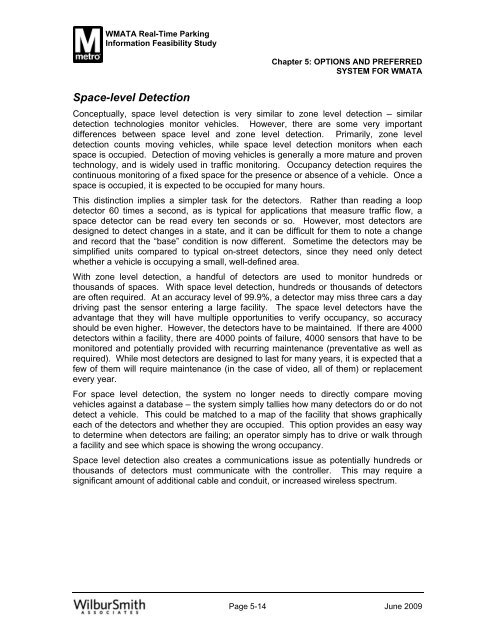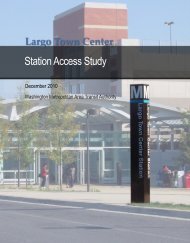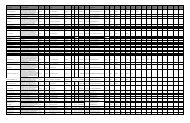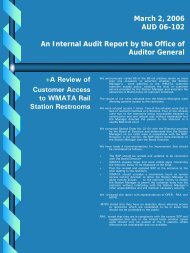feasibility study of real time parking information at ... - WMATA.com
feasibility study of real time parking information at ... - WMATA.com
feasibility study of real time parking information at ... - WMATA.com
Create successful ePaper yourself
Turn your PDF publications into a flip-book with our unique Google optimized e-Paper software.
<strong>WMATA</strong> Real-Time Parking<br />
Inform<strong>at</strong>ion Feasibility Study<br />
Chapter 5: OPTIONS AND PREFERRED<br />
SYSTEM FOR <strong>WMATA</strong><br />
Space-level Detection<br />
Conceptually, space level detection is very similar to zone level detection – similar<br />
detection technologies monitor vehicles. However, there are some very important<br />
differences between space level and zone level detection. Primarily, zone level<br />
detection counts moving vehicles, while space level detection monitors when each<br />
space is occupied. Detection <strong>of</strong> moving vehicles is generally a more m<strong>at</strong>ure and proven<br />
technology, and is widely used in traffic monitoring. Occupancy detection requires the<br />
continuous monitoring <strong>of</strong> a fixed space for the presence or absence <strong>of</strong> a vehicle. Once a<br />
space is occupied, it is expected to be occupied for many hours.<br />
This distinction implies a simpler task for the detectors. R<strong>at</strong>her than reading a loop<br />
detector 60 <strong>time</strong>s a second, as is typical for applic<strong>at</strong>ions th<strong>at</strong> measure traffic flow, a<br />
space detector can be read every ten seconds or so. However, most detectors are<br />
designed to detect changes in a st<strong>at</strong>e, and it can be difficult for them to note a change<br />
and record th<strong>at</strong> the “base” condition is now different. Some<strong>time</strong> the detectors may be<br />
simplified units <strong>com</strong>pared to typical on-street detectors, since they need only detect<br />
whether a vehicle is occupying a small, well-defined area.<br />
With zone level detection, a handful <strong>of</strong> detectors are used to monitor hundreds or<br />
thousands <strong>of</strong> spaces. With space level detection, hundreds or thousands <strong>of</strong> detectors<br />
are <strong>of</strong>ten required. At an accuracy level <strong>of</strong> 99.9%, a detector may miss three cars a day<br />
driving past the sensor entering a large facility. The space level detectors have the<br />
advantage th<strong>at</strong> they will have multiple opportunities to verify occupancy, so accuracy<br />
should be even higher. However, the detectors have to be maintained. If there are 4000<br />
detectors within a facility, there are 4000 points <strong>of</strong> failure, 4000 sensors th<strong>at</strong> have to be<br />
monitored and potentially provided with recurring maintenance (prevent<strong>at</strong>ive as well as<br />
required). While most detectors are designed to last for many years, it is expected th<strong>at</strong> a<br />
few <strong>of</strong> them will require maintenance (in the case <strong>of</strong> video, all <strong>of</strong> them) or replacement<br />
every year.<br />
For space level detection, the system no longer needs to directly <strong>com</strong>pare moving<br />
vehicles against a d<strong>at</strong>abase – the system simply tallies how many detectors do or do not<br />
detect a vehicle. This could be m<strong>at</strong>ched to a map <strong>of</strong> the facility th<strong>at</strong> shows graphically<br />
each <strong>of</strong> the detectors and whether they are occupied. This option provides an easy way<br />
to determine when detectors are failing; an oper<strong>at</strong>or simply has to drive or walk through<br />
a facility and see which space is showing the wrong occupancy.<br />
Space level detection also cre<strong>at</strong>es a <strong>com</strong>munic<strong>at</strong>ions issue as potentially hundreds or<br />
thousands <strong>of</strong> detectors must <strong>com</strong>munic<strong>at</strong>e with the controller. This may require a<br />
significant amount <strong>of</strong> additional cable and conduit, or increased wireless spectrum.<br />
Page 5-14 June 2009

















